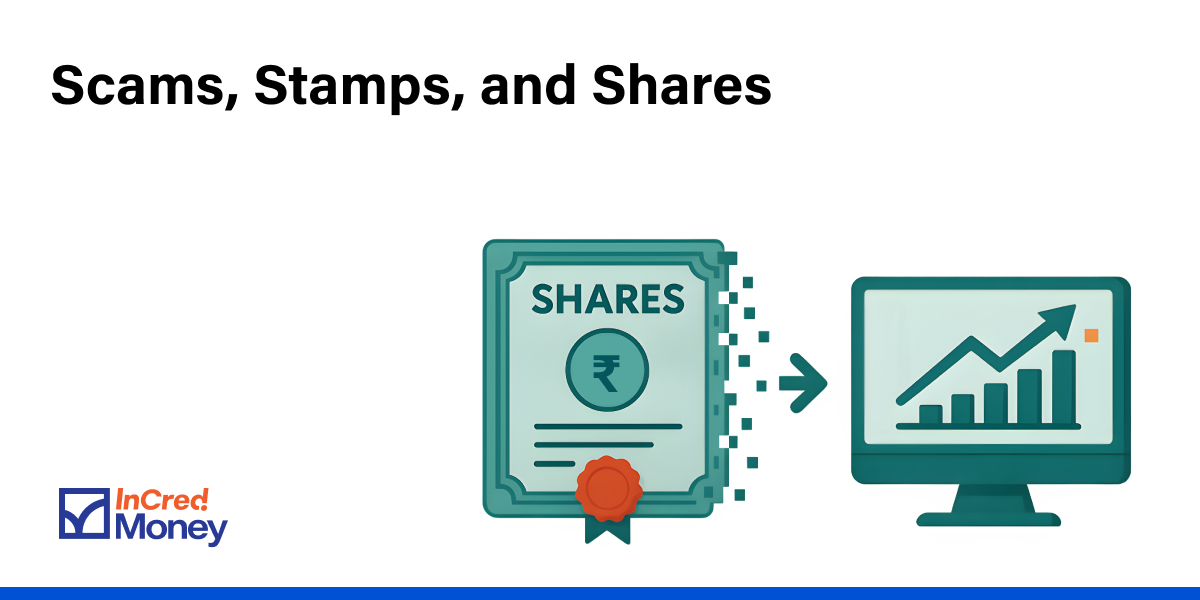A friend called me last week, sounding half-excited, half-confused.
He was cleaning out a drawer at home when he stumbled upon a bunch of physical share certificates his father had invested in during the 90s. “Can I still do something with these?” he asked.
That one call made me realise something: we’ve come to take the ease of today’s demat system completely for granted.
But it wasn’t always this simple.
I got curious and read up a bit about how stock trading was back then.
When Shares Were Actually “Shared” on Paper
Before dematerialization in the late 1990s, trading stocks in India was a slow, paperwork-heavy process.
Investors had to place orders through brokers who manually executed trades on exchange floors.

Once a trade was matched, the seller delivered physical share certificates to the buyer via the brokers. The buyer then had to transfer the share certificates into their name by filling out a deed, affixing stamps, and submitting it to the company registrar.
Basically a lot of paperwork and time!
The entire process took weeks — often months — and was riddled with risks like lost documents, signature mismatches, duplicate or forged certificates, and ownership disputes.
If you wanted to sell? It was a similarly complicated process!
Scams That Exploited the Paper System
Naturally, a paper-based system was ripe for fraud.
1. Fake and Duplicate Share Certificates
This was alarmingly common.
Scamsters would forge physical share certificates — often copying the exact design and signatures — and sell them to unsuspecting investors. Since there was no centralized digital record to verify ownership, investors had no easy way to confirm whether what they held was genuine or a duplicate.
By the time the fraud was discovered, the scammer had vanished, and the investor was left with worthless paper.
Even some promoters were a part of this fraud. Promoters would print extra physical share certificates — beyond the company’s authorized capital — and sell them under the table.
To the unsuspecting buyer, the certificate looked legit: it had the company seal, signature of directors, serial numbers, and sometimes even fake registrar stamps.
2. The Badla System: A Backdoor to Market Manipulation
India had a system called Badla trading, which allowed investors to carry forward trades without taking actual delivery of shares. On paper, this was meant to give flexibility. In practice, it became a tool for speculative trading and price rigging.
Operators would drive up share prices artificially, create a trading frenzy, and exit before retail investors knew what hit them. The absence of real-time settlement or digital records made it hard to trace the manipulation.
But How Did These Scams Get Caught?
In some cases, auditors or alert registrars caught mismatches between the number of shares issued and the capital reported in the balance sheet.
In others, SEBI investigations exposed layers of rigging that began with fake or unauthorized certificates.
While the Harshad Mehta scam wasn’t entirely due to physical shares, it would have been far more difficult to pull off in a fully dematerialized system.
There were other risks as well
1. Theft, Fire, and Water Damage
Physical share certificates were fragile and easily lost to fire, floods, termites (yes, really), or even a home renovation.
Recovery was possible but painfully slow — often requiring affidavits, police reports, and months of chasing registrars.
2. Signature Mismatches and Transfer Delays
Selling shares meant physically signing the back of the certificate. But if your signature had changed even slightly, the transfer could be rejected.
Or if the courier lost your certificate, there was little you could do. And a simple clerical error — like a wrong folio number — could derail the process entirely. Many investors lost real money over such routine issues.
3. The Turning Point: When India Went Digital
After multiple scams and years of inefficiencies, the markets had had enough.
In 1996, the National Securities Depository Limited (NSDL) was set up. This marked the beginning of dematerialization — the process of converting physical share certificates into digital format.
Soon after, the Central Depository Services (India) Ltd. (CDSL) joined in. Together, they helped India transition from paper to pixels.
By the early 2000s, most new IPOs and stock trades were only allowed in demat form. Today, nearly 100% of listed shares on Indian stock exchanges are held electronically.
Not just the listed companies, even unlisted ones (other than small private companies), must hold their shares in the demat format.
So, What If You Still Hold Physical Shares?
Like my friend, if you have also discovered some of those old certificates lying around, don’t worry. You can still convert them.
Here’s how:
1. Open a demat account if you don’t already have one.
2. Fill out a Dematerialization Request Form (DRF) with your depository participant (your broker).
3. Submit it along with the original share certificates.
4. The company’s registrar will verify and credit the shares to your demat account.
Simple. But do it soon!
From Trust Issues to Trustworthy Systems
Dematerialization didn’t just make investing faster — it made it safer.
There’s less scope for fraud, faster settlements (T+1 now!), and a far more inclusive
investing environment. It’s one big reason why millions of new investors have entered the stock market in recent years!
Bonus: A Great Read on This Transition 🐂📘
If you’re curious about how India’s stock markets evolved — especially from the scam-riddled ’90s to the tech-driven 2010s — I highly recommend Bulls, Bears and Other Beasts by Santosh Nair.
It’s part memoir, part market history, and all very readable.
I hope you enjoyed this newsletter and if you did, feel free to share it with your friends and family.
Also, if you have any topics that you would like us to cover or any other feedback, do write to us at connect@incredmoney.com.
Till the next time,
Vijay
CEO – InCred Money




